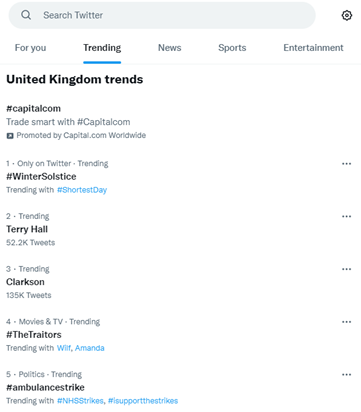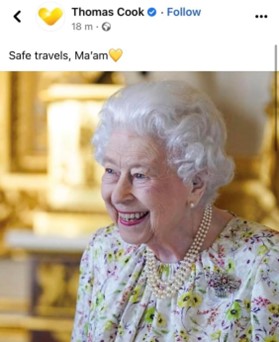Digital Marketing Update: Google sets new standards for links and content
Google sets new standards for links and content, new functionality emerges in Analytics and Search Console, and new tool Neurons hits the world of...
Read moreWhat are trends, and when should brands be jumping on them as part of their digital publis relations strategy? Head of Digital PR, Jennie Lindehoff, tells us more.
According to Cambridge Dictionary, trend is a general development or change in a situation or in the way that people are behaving. Trend is mostly known as a term in fashion but a trend can happen in any area and across any topic.
In business, a trend can be a change in certain processes or conditions. For example, due to Covid-19, people started to work from home and more have stayed working from home since. Result - there has been a trend towards working from home more often and businesses offering remote working contracts.
In social media, if something is trending, it means that lots of people are sharing posts about the same topic. For example, when you log on to Twitter and navigate to the ‘# Explore’ section, you find what’s trending on Twitter (most used hashtags) in your area in real time. The number that pops up next to a hashtag when you’re about to include it in an Instagram update indicates how many users have included that particular hashtag in their posts. Therefore, you can see on both of these platforms how many people are talking about, and engaging with, certain topics.

We’ve picked out five examples of Google trends we’ve seen in 2022 and given reasons as to why they happened.
There was a surge in electric cars being bought in the UK, with battery electric vehicle sales going up by 48.8% in the last year.
Why: Petrol prices went up which meant that people looked for cheaper options elsewhere. Investing in an electric car cuts out the petrol cost so, therefore, electric cars saw an upswing in sales.
Second-hand shopping had an uplift in interest and purchases, with second-hand sales peaking over summer in the UK, with an average sales value increasing from £30 in February to £200 in June.
Why: Love Island’s launch episode in 2022 had 5 million views, the show’s largest premiere so far. With so many eyes on the contestants and their partnership with eBay meaning they were only wearing pre-loved clothes on the show, more people had a positive perception of second-hand clothing, and 23% of Love Island viewers made pre-loved purchases.
The Crown’s viewership increased massively across the world. The UK alone saw an 800% increase in viewers, figures quadrupled in the U.S., and streaming tripled in France.
Why: Queen Elizabeth II passed away on 8th September 2022 leading to more people watching The Crown on Netflix.
On the internet, the buzzword of the year has been Metaverse. Conversations about it have grown in 2022, with over 300,000 articles being published about it this year.
Why: Metaverse isn’t a new thing, the term was first used in 1982, in Neil Stevenson’s novel Snow Crash. However, with Facebook changing its name to Meta at the end of 2021, this indicated that a big focus for the brand is to shape the future of the metaverse.
Freedom of speech on social media has dominated the social conversations on the back of a surge in the use of the N-word on Twitter, with usage increasing by 500%.
Why: Kanye West was banned from Instagram and Twitter after he allegedly made a series of antisemitic comments. Later, in the same month, Elon Musk bought Twitter. Though he assured advertisers that he didn’t want the platform to become “a free-for-all hellscape, where anything can be said with no consequences”, ot long after the switch in Twitter owners, the use of the N-word on the platform increased by 500%.
As you can see, these five trends all happened at the right time, in the right place, in the right moment and with the right people to gain the momentum and results that they did. Trends constantly exist, some longer than others and some with a bigger impact than others. But why do we all love them so much?
The reason why people love trends and jump on them is because it gives them a sense of belonging. If you join a trend, you’re “in” and part of a group. To humankind, a sense of belonging improves our happiness, health (mental and physical), and it gives us purpose. On the flipside, not feeling like we belong can lead to stress, illness and depression.
For journalists, trends are great to write about as when they happen, as people will be searching for a specific term to find more information. If a journalist has covered the story, their articles are more likely to get more readers and engagement. Like our clients, journalists and online publications look at reach, traffic, and engagement from their readers.
Over the past few years, there’s been a trend (see what I did there…) in digital journalism with publications setting up new desks and hiring specialist reporters in the field. It’s not uncommon to see a journalist’s job title include the word ‘trends’.
Both people and journalists love trends and so do we! In a nutshell, working in Digital PR, it’s important to understand what trends are and how to utilise them to our advantage to bring in results for our clients. Trends are happening constantly and if our clients have useful information and insights to share about the trend and the topic, we want them to and will support them in making it happen! But not all trends are worth jumping on.
For brands to stay relevant and be seen as trustworthy in their industry and with their customer base, it’s important to know which trends to jump on, and when.
Before you jump on a trend, ask yourself “Is it relevant and a true representation of who we are and what we stand for?”. Also, think about if it is relevant to what your audience is talking about and if it’s something they’d actually like to hear about. Would it be an example of helpful content for them?
To easily demonstrate, let’s look at a recent example of how not to do it.
When Queen Elizabeth II passed away, lots of brands shared their condolences across social media, as many wanted to express their sadness and acknowledge what was a momentous event in history. If you do decide to acknowledge tragic events, don’t make it about you. See this example from Thomas Cook. A social share which was taken down a short while after (not quick enough for people to screen save…).

Image C/O: Thomas Cook
Though for many trends, tying it into your product or service with a bit of humour is more than appropriate, when it comes to trends that spring from a tragic event, it’s best to keep it straightforward, if you choose to acknowledge the topic at all. When Thomas Cook shared a photo of the Queen with the caption “Safe travels, Ma’am 💛”, their humour did not come across well, as they were using what should have been a sombre moment for their own brand.
You won’t be the only brand looking out for trends so be picky in the trends you do jump on. You don’t want to risk your input getting lost if everyone is jumping on the same trend. Ideally, you want to be the first one out there for it not to become “old” news. Should you wait a bit longer, your inputs should add something new to the table. If you have further research and new data to include – great. Or if you’ve seen an opposite effect – share it to start a discussion.
All of these questions above can be explored in much more detail, which I plan to do over the coming months. But, to finish for now, let’s look at an example of what we did for one of our clients in the home care provider industry.
Covid-19, Brexit and recruitment have been hot topics in the care sector for a while now and when the news from Home Office broke about health workers getting free UK visa extensions, it was a great opportunity for our client to share their thoughts.

Image C/O BBC News
When the above news broke, our client provided a comment on how this affected care workers differently to NHS staff. A comment we shared, on the same day as the news broke, with relevant care and health publications who picked it up and included the comment in their articles about the visa extension update.

Image C/O Home Care Insight

Image C/O Care Home Professional
While many were celebrating the extension for healthcare professionals, our client added an alternative viewpoint to the discussion, pointing out that, in reality, a key group of people were facing exclusion – despite the fact that, they to, had been classed as important, key workers in the pandemic.
In summary, trends are inevitable, press like to talk about them, and people want to engage with them. If the trends are relatable to your brand and topics you and your audience like to interact with, take advantage! Be part of the discussion to build brand awareness, and start some interesting conversations!
If you’d like to find out more about trends and how we can incorporate them into your PR strategy, get in touch with our team.
Photo by Bekky Bekks on Unsplash
More articles you might be interested in:

Google sets new standards for links and content, new functionality emerges in Analytics and Search Console, and new tool Neurons hits the world of...
Read more
Welcome to the latest round-up of all things digital. This is where we look at the latest updates in the world of PPC, SEO, Content and International...
Read more
Find out how we utilised existing content for two of our health clients during Dementia Awareness Week and secured a 600% increase in referral...
Read more
A great PR campaign is for life - not just for Christmas! Jennie Lindehoff tells us how to make a seasonal PR campaign last all year round.
Read more
The Metaverse is on its way and conversation is growing. But how might Metaverse marketing look? Join Content Specialist Regan Foy as he theorises.
Read more
Episode Five of The Assorted Digital Ramblings Podcast is now available! Learn all about Digital PR and Outreach with special guest Jennie.
Read more
Can we influence you to utilise influencer marketing? Learn how to use influencer marketing to grow your brand with our insightful blog post.
Read more
What qualities do you need to get into Digital PR? Digital PR Executive, Hannah Jordan, shares 6 tips for getting a job in digital PR.
Read more